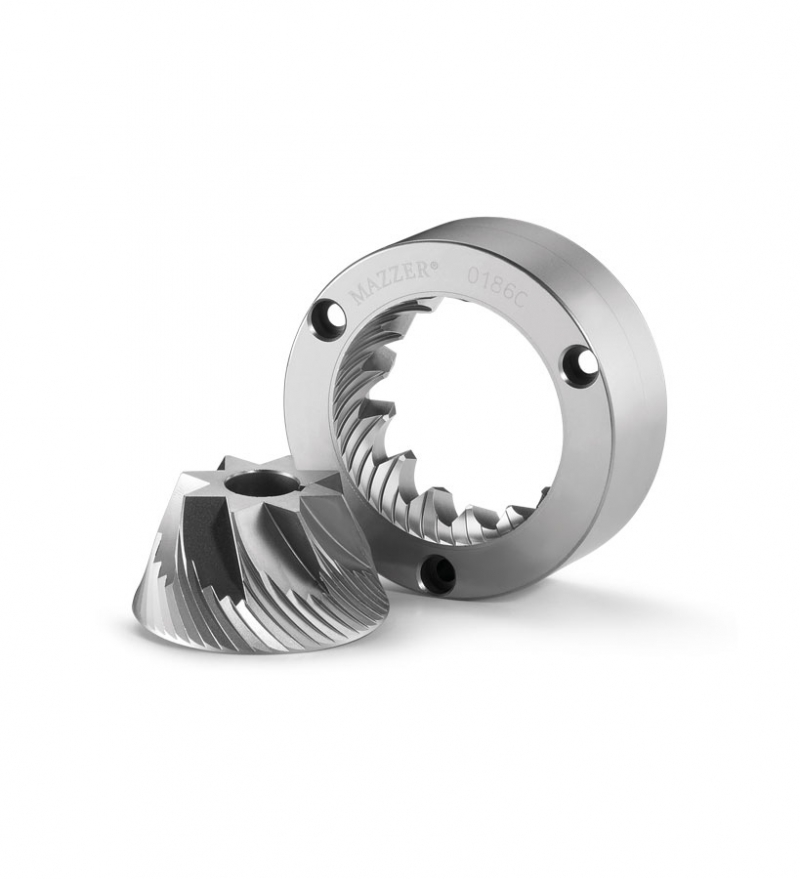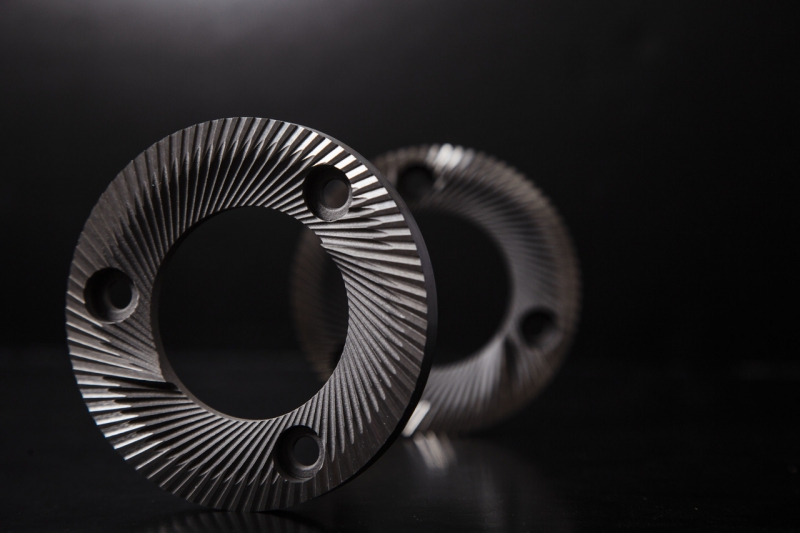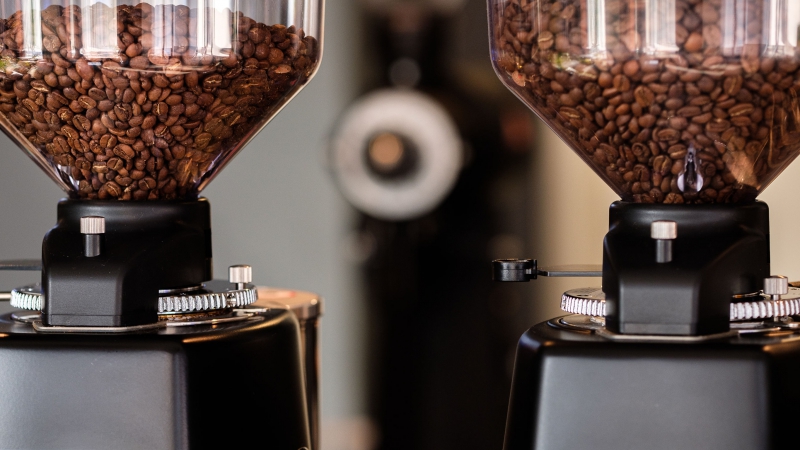The Cutting Edge: Inside your coffee grinder
Words by Kyle Ramage, Black&White Coffee Roasters
The burrs are arguably the most important part of your coffee grinder and Kyle Ramage, US Barista Champion 2017 and co-owner of Black&White Coffee in Raleigh, North Carolina, has had over 10 years experience on the technical side of these integral pieces of coffee equipment.
I’m going to try and give you a basic breakdown of what’s going on inside a coffee grinder, specifically the ones you see at your local cafe every day.
Firstly, let me just give you the lay of the land. I worked with Mahlkönig which is exclusively a flat burr manufacturer. There’s only a few major coffee burr manufacturers in the world. MKT (Mahlkonig Technologies) which is kind of a hodgepodge of Ditting and Mahlkönig grinder products which are in a ton of super automatic machines as well as of course the grinders that are branded by those two companies. Then there are two major companies in Italy that make burrs for most of the other coffee equipment brands. These names are only known to people deep within the industry, but they make burrs for the Nuova Simonelli Group and Anfim. Mazzer makes most of their own discs. Innovation in grinders takes place at this level of production, as the focus has been on disc technology over the last 10 years and how the discs in the grinder impact flavour.

There are two main styles of burrs. Conical and Flat. Functionally conical and flat burrs are designed to do the same thing, essentially they turn big bits into smaller bits. All I know is what I’ve experienced and in my experience, conical discs tend to make a grind profile that is a bit different and in my opinion, not as good as flat discs. If you look at it as a mountain of grounds, it would be a quite broad mountain of particle distribution sizes. Meaning that there is quite a big difference between the smallest and biggest pieces even within the median grind profile. This does some really interesting things for extraction. It makes extraction a little bit uneven, but it makes it flow really consistently, which is super interesting. They are pretty forgiving on coffees. So back in the day when I really got into coffee in 2007/2008, conical burr grinders were everything, right? If you didn’t have a conical burr espresso grinder you were not about the coffee life! What I learned is that they do they work really well for a darker roasted coffee, that you don’t really want to extract with super high TDS (Total Dissolved Solids), but you really want those thick and viscous ristretto, old school, full crema shots. That’s where they excel and they can make really great espresso for milk beverages.

Flat disc grinders on the other hand, tend to make coffee that is a bit more transparent, meaning the coffee is a little bit more vibrant, has a little bit more clarity to its extraction style. This is really seen in the market in two main manufacturers. Both of them kind of stumbled upon this flat burr revolution, in my opinion, by accident. Basically as the trend in coffee moved towards clarity and vibrancy, flat burr grinders became more in vogue. So then there are a further two styles of flat burrs; The ones made for the Nuova Simonelli (NS) Group grinders that have done a lot of work with coatings (we will focus on that a bit later when we talk about materials) and then there’s Mahlkönig. In my experience with the discs in the NS grinders and the Anfim grinders they make coffee that’s an interesting hybrid between the two disc styles. They still have quite a wide particle distribution, which makes the coffee flow in a really pretty way, but it’s significantly more uniform than a conical burr grinder, so they produce shots with a very consistent flow rate.
A difference between a Mazzer Robur or any big conical grinder and then an EK43 for espresso, even if you’re just like looking anecdotal evidence, the more consistent the grind profile or the more consistent all the particles are inside, the more consistent extraction you’re going to get. So your shots will have a little bit more vibrancy and there’ll be more transparency of the coffee flavours. Which can be a good thing for coffee competitions but it may not be the desired effect for the café space. Uniform does not necessarily equal better, it just equals more consistent. So that also has knock on affects on usability in the café in my opinion.

Mahlkönig grinders tend to be more finicky when it comes to heat management and grind settings, because of the fact that they are physically more uniform in particle distribution. So this means it takes a little bit more care and a lot more attention to detail to manage a grinder that has more consistent particle size distribution. Basically, when you’re moving the mechanism to change the grind up and down you’re actually moving it pretty far from the original particle size, probably a lot further than you think, so it could be a little bit more finicky to keep in check. I like the EK43 (originally designed for commercial bulk grinding), but they’re also super finicky for that same reason; the more uniform the grind, the more difficult they’re going be to use. Because you have to get the setting exactly right for each coffee. Whereas with the Mazzer Robur, there’s a lot more give and a lot more room to play with to get a good result. It’s like cars. If you look at the street cars that we drive everyday and are very used to driving, they’re really soft and squishy and really easy to use, because they’re designed to be driven everyday. But a race car or even a car that isn’t designed for comfort, are much more difficult to drive, much more harsh, crazy intense and a lot more feedback to the driver. So the same is true of coffee grinders, the more you get to the ragged edge of what’s possible, the more difficult they are to control and use.
Grinders, especially commercial ones, have large electric motors. That’s actually how I affectionately referred to myself when I was selling grinders, an electric motor salesman. The EK43 is quite well known for having a massive one, because it really wasn’t designed for café service, it was designed more for a small commercial grinding solution. The burrs really are the star of the show but if you attach great burrs to a bad motor you’re going to have issues. The width of the burrs will impact the speed too, as the more surface area you have, the more coffee can go through at one time.
Then we get to burr material. Does it make a difference? In my experience, absolutely! There is a lot of research being done and that will be released soon, so I don’t want to give away information that isn’t mine, but yes absolutely burr material makes a big difference. Maybe not necessarily in particle uniformity but in my experience in flavour, which is all I honestly care about. Whatever the laser particle analysing machines tell me is somewhat useful, but what matters is what’s in the cup at the end of the day, right? I did a lot of data collection which was much more qualitative, and in terms of flavour, I’ve been a big advocate of cast steel discs from the very beginning. I am not an advocate of coatings at all. Every coated disc (nitride for example) that I’ve used in my opinion it tasted worse than their uncoated counterparts. And we got into this quite a lot with Anfim. My sample set was only like 30 or 40 shots, but the shots yielded about half a percent lower extraction than when we used the non-coated discs. The other thing to consider is that coated disks are like five times the price so yeah that answers that question for me.
The way I think about material for burrs is the same way I think about choosing a chef’s knife. You know when you go to the shops and they have those stainless steel knives and they’re just really smooth and they’re reasonably priced and then you take them home and everything in the world sticks to them, especially cheese when you’re trying to chop it or anything really, just sticks to side of the blade. And then if you think about the high end knives, especially from Japan, you will see those surfaces are a little more rough, and not quite as mirror finished. The more mirror finish a metal has and the smoother it is, the more chances you have for things to stick to it. In my experience with burrs, the rougher the non-cutting edge of a disc, the breaker parts of a disk are, the more easily the coffee is going to flow through and not get stuck in the shoot, which is going to give you a lower heat retention in the grinder and going to give you a little bit easier throughput for the machine which tends to help with a little bit higher extraction.
I still keep up with the with the Mahlkönig crew, we do a lot of testing for them here in our cafés. We have three cafés here in North Carolina and interestingly enough we have just pulled two of our Peaks from our flagship store and we opened them up to have a look at how they were coping. One of the machines had 100,000 shots ground and the other one had 140,000 shots of espresso on one set of Peak cast steel discs. And they are still in perfect condition. We are very impressed with how long they’ve lasted and the quality they produce.
In terms of what is new on the market, I’ve had the chance to test both the Mahlkonig E80 and E65 Grind by Weight. The E80 is like the Peak, but better, it has a more powerful motor, better internal fans, significantly better user interface. I was really happy with how that’s turned out. They have a 3 second grind time for an 18 to 20g espresso, it’s pretty rad! We chose cast steel discs for the grinder, which is a upgrade you have to pay more for, but the flavour has just been insane. Then the other machine that is in our café that has been freaking rock solid has been the E65. This is the machine that I was working on back when I worked there about 4 and a half years ago, it’s a grind by weight solution. You can clip the portafilter in, it weighs the portafilter, tares the scale and and grinds the coffee straight into the basket to within a 10th of a gram and is just super rock solid consistent. I’ve also loved the new interface. From what I understand they worked with an app developer on this particular one and it’s just been amazing how they were able to utilize very logical things to make it a very easy to use menu, very easy to adjust the timer for the grind, very easy to use everything, which has been fantastic. And also maybe not super relevant but some super cool light stuff. I work in live audio production too, and lights and colour help that process a lot, so they’ve brought this sort of haptic style into the grinder. When it’s grinding it’s green and when it’s done it’s white, which makes it a multi-level communication device which is easy to understand, I’m impressed they’ve thought that far ahead. I think this is going to be the future of how we measure all our equipment, how easy all of our espresso machines and all of our grinders are to use and work with, because now we all have smart phones in our pockets that are super intuitive and logical to use.